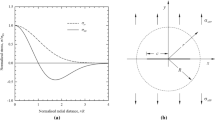Abstract
Preliminary results are reported, describing experiments in which a slot is cut into a specimen under load. Under plane stress conditions this procedure produces a very diffuse plastic zone while under plane strain conditions a multiple series of hinge-type zones is formed. These results are contrasted with the behavior of specimens which are loaded after the slots are cut in. It is suggested that the differences are due to redistribution of stresses resulting from formation of the plastic zone.
Résumé
On rapporte les résultans préliminaires d'expériences consistant à couper une fente dans un spécimen sous charge. En cas d'efforts plans, cc procédé engendre une zone plastique très diffuse; en cas de distortions planes, une série multiple de zones a charnières se forme. On oppose ces résultans au comportement de specimens soumis à une charge une fois les fentes faites. On suggère que les differences sont dues a la redistribution d'efforts résultant de la formation de la zone plastique.
Zusammenfassung
Den berichteten vorläufigen Versuchsergebnissen gemäss wurde ein Schlitz in ein belastetes Probestück geschnitten. In dem ebenen Spapnungszustand bring dieses Verfahren eine sehr diffuse plastische Zone hervor, während in dem ebenen Verzehrungszustand eine veilfache Reihe Scharnierartiger Zonen gestaltet wird. Die Ergebnisse werden dem Verhalten von Probestücken, die nach dem Schlitzschneiden belastet werden, gegenüberstellt. Es wird angedeutet, dass die Unterschiede auf die Spannungsneuverteilung, die von der Bildung der plastischen Zone verursacht wurde, zuriickzufiihren sind.
Similar content being viewed by others
References
D.S. Dugdale J. Mech. Phys. Solids, 8,100 (1960).
B.A. Bilby and K.H. Swinden Proc. Roy. Soc., A285, 22 (1965).
G.T. Hahn and A.R. Rosenfield ASTM STP, 432, 5, (1968).
G.T. Hahn and A.R. Rosenfield The Relation of Engineering Mechanics Research to the Practice of Civil Engineering, American Society of Civil Engineers, Washington, p. 351 (1966).
M.F. Kanninen, A.K. Mukherjee, A.R. Rosenfield, and G.T. Hahn ‘The Speed of Ductile Crack Propagation and the Dynamics of Flow in Metals’, presented at the Symposium on, The Mechanical Behavior of Materials Under Dynamic Loads, Springer-Verlag, New York (to be published).
F.A. McClintock J. Appl. Mech., 25, 582 (1958).
F.A. McClintock Proc. Roy. Soc., A285, 58 (1965).
F.A. McClintock Drucker & Gilman, eds Fracture of Solids, Wiley, New York, p. 65 (1963).
F.A. McClintock and G.R. Irwin ASTM STP, 381, 84 (1965).
G.T. Hahn and A.R. Rosenfield Acta Met., 13, 293 (1965).
A.R. Rosenfield, P.K. Dai, and G.T. Hahn Proc. First Int. Conf. Fracture, 1, 223 (1966).
H.C. van Elst Trans. AIME, 230, 460 (1964).
Author information
Authors and Affiliations
Rights and permissions
About this article
Cite this article
Hahn, G.T., Rosenfield, A.R. Plastic zones generated by cracks growing under load. Int J Fract 4, 79–88 (1968). https://doi.org/10.1007/BF00188935
Received:
Issue Date:
DOI: https://doi.org/10.1007/BF00188935




